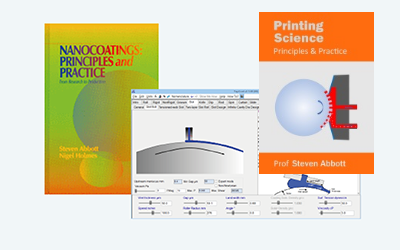Refractive Index
Quick Start
Because the refractive index of a medium has a big effect on the optics of scattering and reflection, tuning the RI to a chosen value can be important. If nanoparticles are small enough not to scatter, then they can be used to create some high RI formulations.
Here you get to mix some nanoparticles which might have high RI with some resins of more normal RI. Enter the weights of each component (the program normalises them to 100%) and their densities and RI. The resulting RI is calculated by two well-known methods.
Refractive Index
| Weight | Density | RI | |
|---|---|---|---|
| Nano 1 | |||
| Nano 2 | |||
| Resin 1 | |||
| Resin 2 | |||
| Resin 3 | |||
| Resin 4 |
| Nanoparticle | Density g/cc | RI |
|---|---|---|
| Silicon dioxide | 2.65 | 1.458 |
| Aluminium oxide | 4.05 | 1.726 |
| Zinc dioxide | 5.61 | 2.004 |
| TiO2 Anatase | 4.23 | 2.488 |
| TiO2 Brookite | 4.23 | 2.583 |
| TiO2 Rutile | 4.23 | 2.609 |
| Cerium oxide | 7.65 | 1.900 |
| Tin oxide | 6.95 | 2.006 |
| Bismuth oxide | 8.9 | 2.400 |
| ITO | 7.14 | 1.764 |
The RI of a nanoparticle formulation can be calculated from the average of the volume fractions of the resin, the nanoparticle and (importantly) the stabilising shell around the particle - assuming that the particles are small enough that there is no scattering. The calculated value depends on the type of average. The Volume fraction average is the simplest to calculate. Others prefer the Lorentz-Lorenz model, so called because it happened to be independently discovered by Lorentz in the Netherlands and Lorenz in Denmark in 1878 and 1869. The formula is too complex to show here.
Simply enter the weights (they don't have to add to 100!) of up to two nanoparticles and up to four resins (or shell materials) along with their densities and RI. Any row containing a 0 is ignored. The Volume and L-L RI are calculated for you. A list of nanoparticle densities and RI is provided below.
It is important to take into account the shell into calculations (see the Shell app); for example, commercial Cerium Oxide nanoparticle are surrounded by a thick stabilising shell which alters the "real" nanoparticle value significantly.


